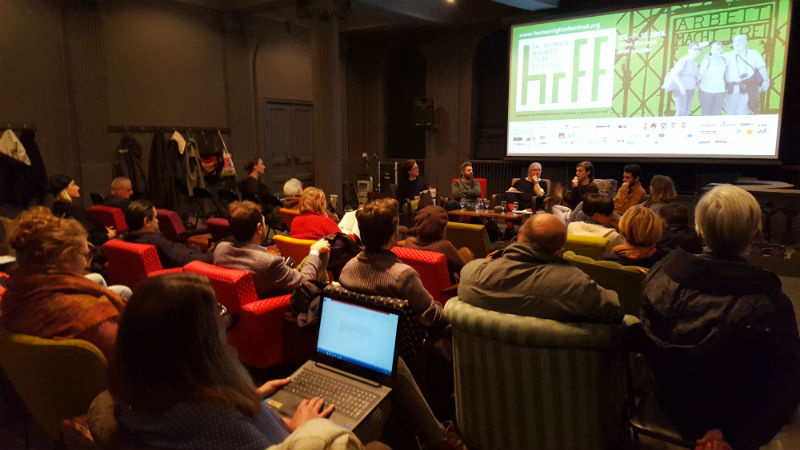The round table discussion „Human Rights Protection Going Downhill: Successes and Failures of Activist Practices in the Region“ was held on December 7, 2017 in the scope of the Human Rights Film Festival Zagreb. The event involved 54 citizens, including 49 participants from Croatia, 2 participants from Serbia, 1 participant from Macedonia and 2 participants from Bosnia and Herzegovina.
The round table was attended by 54 participants, including 2 participants from Serbia, 2 participants from Bosnia-Herzegovina, 1 participant from Macedonia and 49 participants from Croatia. It reached a wider audience through the HRRF newsletter and follow-up media reports. It was held in the scope of GONG’s regional project “Civic Activism and Resistance in Retrospect: (post)-Yugoslav region 1980-2016: RETROaktiva” supported by the Europe for Citizens Programme of the EU.
Antonija Letinić from Kurziv moderated the discussion about various avenues to citizen mobilization, problems, solutions and consequences of recent activist initiatives in Serbia, Bosnia-Herzegovina, Macedonia and Croatia that advocate for direct democracy and protection of public goods. Five prominent social and cultural activists from the region compared and critically examined their recent local struggles in Skopje, Zagreb, Belgrade and Banja Luka for the protection of public spaces at risk of privatization and urban devastation, exploring the limitations and innovative tactics of artist-activist coalitions aimed at effective citizen mobilization against undemocratic clientelistic practices.
The first local practice examined was the citizens+ revolt against the notorious urban revisionist project Skopje 2014 which devastated the entire urban core of the modernist city. Several years of protests, petitions and cultural actions against the project channelled into the Colourful Revolution in 2016 against the authoritarian and corrupt government under Gruevski and VMRO/DPMNE. „Citizens were denied any right to information about the Skopje 2014 project – when you have no right to know, you have no means to act.“, pointed out Ivana Dragšić from Freedom Square, qualifying the Skopje protest actions as an example of failure since urban devastation was not stopped. Nevertheless, the actions enhanced a sense of common goal and solidarity among citizens, activists and organizations of very different views, through a dynamic dialogue entailing a lot of examination, discussion and confrontation. The protests hence built the base for a massive revolt through the „Colourful Revolution“, critical to the eventual change of Government in 2017. She pointed out that “the whole process was the process of unification, fragmentation, filtering and re-unification of initiatives and actors on the civil scene.“
The initiative Ne da(vi)mo Beograd! (Don’t let Belgrade d(r)own) was presented by Andrija Stojanović, highlighting that the protests and massive citizen mobilization were only its most visible aspect. The initiative grew out of the need to articulate the two levels of the problem that marks the hyper-ambitious commercial development project Belgrade Waterfront. The first level relates to the devastation of urban space, as diagnosed by the professional community of urban developers The second level relates to the lack of transparency and democratic process in the project planning and implementation. Andrija highlighted regime’s brutality as a key mobilization factor: “Over night, the entire local neighbourhood of Sava Mala was literally destroyed which is an act of violence and injustice. That act was the key mobilization factor for involving a broader community in our initiative.”
The additional communal actions examined against devastation of public parks in Zagreb (Čuvamo naš park/ We Protect our Park) and Banja Luka (Naš Park / Our Park) are very similar to each other as the indicate almost identical problems of a lack of transparency and clientelistic privileging of private investors at the expense of public spaces and citizens’ quality of life. Both examples also show site-specific violations of public spaces and civic rights can mobilize wider circles of citizens and enhance their sense of communal identity.
Dragana Dardić from the Helsinki Citizens’ Assembly in Banja Luka described the Our Park initiative as the most durable and the most massive citizens’ initiative in Republic Srpska. It had no particular political profile, no leader and no media support – it fully relied on the power of -social networks. Its actions included protests, long-lasting and massive protest marches through the city, public appeals and advocacy for transparent procedure and access to information. The Government by means of further legislative restrictions in order to prevent such massive citizens’ mobilization in the future, i.e. it expanded the concept of public space to social networks to restrict and control the citizens’ right to assembly. In turn, it limited civic space for action. Even though the initiative was not successful in terms of its goal to prevent the devastation and privatization of public park, it was very productive in inspiring new civic initiatives for the protection of public goods, some of which are very successful. On the other hand, Tomislav Domes from Right to the City ponted out that the initiative “We Protect Our Park“ in the Zagreb neighbourhood of Savica manage to articulate the problems and a public interest matter, which was instrumental for its success.
„The discussion has shown us that movements grow next to each other. Actually, these are political movements and I am not sure how long they can survive only in the scope of civic society „ concluded Borka Pavičević from the Centre for Cultural Decontamination in Belgrade. She pointed out the vital importance of connecting different movements into one whole, from the sphere of human rights protection to the sphere of cultural policy because „democracy exists in these spheres, between the centres of power. “
The final question discussed related to the need for continuation of such issue specific civic actions – should there be follow-up, what happens later with the mobilized social energy and can one give up afterwards. The participants agreed that the principal value of such initiatives was building the civic culture resistance, as a prerequisite – regardless of failures and frustrations – for any kind of change.

